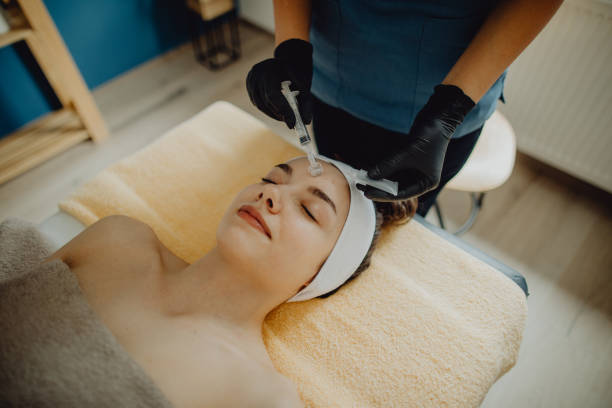Microneedling is a minimally invasive cosmetic procedure that involves using a device with fine needles to create tiny punctures (micro-injuries) in the skin’s surface. These micro-injuries stimulate the body’s natural wound healing process, which can help improve the appearance of the skin by promoting collagen and elastin production. While microneedling can be an effective treatment for various skin concerns, there are potential mistakes and risks associated with the procedure. Here are some common mistakes to avoid:
- Lack of Professional Training: Microneedling should be performed by a trained and qualified professional, such as a dermatologist, plastic surgeon, or licensed aesthetician. One of the biggest mistakes is attempting to perform microneedling at home without proper training, which can lead to complications and adverse effects.
- Using Non-Sterile Equipment: It’s crucial to use sterile microneedling devices and disposable needle cartridges for each treatment. Using non-sterile equipment can increase the risk of infection.
- Incorrect Needle Depth: Microneedling devices allow for adjustable needle depths. Using the wrong needle depth for a specific skin concern or skin type can lead to ineffective results or skin damage. For example, using too shallow a depth may not stimulate collagen production effectively, while using too deep a depth can cause scarring.
- Overlapping Passes: Overlapping needle passes during the procedure can lead to excessive trauma to the skin, increasing the risk of complications and longer recovery times. Proper technique involves precise, non-overlapping passes.
- Insufficient Skin Preparation: Preparing the skin before microneedling is essential. Failure to cleanse the skin thoroughly and remove makeup, dirt, and oils can lead to increased risk of infection and poor treatment results.
- Not Using Topical Anesthetics: Microneedling can be uncomfortable, and some patients may find it painful. Not using a topical anesthetic or numbing cream can make the procedure unpleasant for the patient.
- Inadequate Aftercare: Proper post-treatment care is essential for optimal results and to reduce the risk of complications. This may include avoiding sun exposure, using gentle skincare products, and following the post-treatment instructions provided by the practitioner.
- Treating Active Acne or Infections: Microneedling should not be performed on skin with active acne breakouts, infections, or open wounds. Doing so can spread bacteria and worsen the condition.
- Inconsistent Treatment Schedule: To achieve the desired results, microneedling often requires a series of sessions spaced apart at appropriate intervals. Skipping sessions or not adhering to the recommended treatment plan can hinder progress.
- Not Managing Expectations: Microneedling can yield significant improvements in skin texture and appearance, but it may not be suitable for all skin concerns. Patients should have realistic expectations and understand that multiple sessions may be necessary for optimal results.
It’s essential to consult with a qualified practitioner before undergoing microneedling to assess whether it’s the right treatment for your specific skin concerns and to receive personalized guidance on the procedure. Additionally, always ensure that the practitioner follows proper hygiene and safety protocols to minimize the risk of complications.

How do I get the best result in microneedling?
To achieve the best results with microneedling, it’s essential to follow a comprehensive approach that includes pre-treatment preparation, the microneedling procedure itself, and post-treatment care. Here are some steps to help you get the best results from microneedling:
- Consultation with a Qualified Professional:
- Schedule a consultation with a qualified dermatologist, plastic surgeon, or licensed aesthetician who has experience with microneedling.
- Discuss your specific skin concerns and goals to determine if microneedling is the right treatment for you.
- Pre-Treatment Preparation:
- Follow your practitioner’s pre-treatment instructions, which may include avoiding certain skincare products (e.g., retinoids) and discontinuing blood-thinning medications before the procedure.
- Arrive at your appointment with clean, makeup-free skin to minimize the risk of infection.
- Topical Anesthesia:
- If you are concerned about discomfort during the procedure, ask your practitioner about the use of a topical numbing cream or anesthetic. This can make the procedure more comfortable.
- Customized Treatment Plan:
- Work with your practitioner to create a customized treatment plan that addresses your specific skin concerns. This plan may include the recommended number of sessions and the ideal needle depth.
- Professional Microneedling Procedure:
- Ensure that the microneedling procedure is performed by a skilled and experienced professional using sterile equipment and disposable needle cartridges.
- The practitioner should use the appropriate needle depth and technique for your skin type and concerns.
- Avoid overlapping passes, as this can lead to excessive trauma to the skin.
- Post-Treatment Care:
- Follow your practitioner’s post-treatment instructions carefully. This may include the use of specific skincare products and avoiding sun exposure.
- Use a gentle, hydrating skincare regimen, avoiding harsh or active ingredients for a few days after the procedure.
- Apply sunscreen with high SPF daily to protect your skin from UV damage.
- Multiple Sessions:
- Understand that microneedling often requires a series of sessions spaced several weeks apart to achieve optimal results. Be patient and consistent with your treatment plan.
- Manage Expectations:
- Have realistic expectations about the results. Microneedling can improve skin texture, reduce fine lines, and address certain skin concerns, but it may not provide a dramatic transformation for all issues.
- Follow-Up and Maintenance:
- After completing the initial series of microneedling sessions, discuss a maintenance plan with your practitioner. Periodic touch-up sessions may be recommended to sustain the results.
- Avoid Sun Exposure:
- Minimize sun exposure before and after microneedling, as UV radiation can increase the risk of complications and compromise results.
- Maintain a Healthy Lifestyle:
- A balanced diet, proper hydration, and a healthy lifestyle can contribute to better skin health and enhance the results of microneedling.
Remember that individual results can vary, and it’s essential to follow your practitioner’s guidance and recommendations throughout the microneedling process for the best possible outcome.
